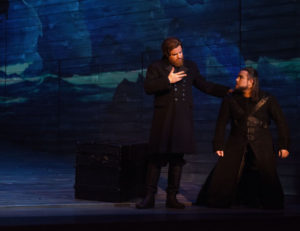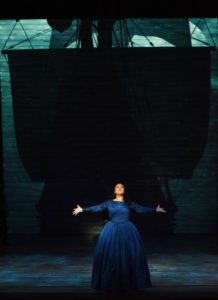The curtain opened on a three-sided set of wood walls that rose from stage floor to flies. Projected on the surface of these walls was a film of stormy sky and sea separated by a line of seemingly enormous craggy cliffs. The deep blue sky was coursed by turbulent clouds; waves rose in turmoil. Agitated movement flowed across the entire stage, only to be replaced by equally striking imagery. Out of a blood-red world the silhouette of a ship appeared. Flames engulfed the stage as the Dutchman sang of Satan’s curse that he must roam the seas for eternity. Planets collided. The shadowy figure of a huge angel grew from smoke and flames. Snow fell among the pine covered fjords and haunted eyes rose over a group of women spinning.

Such powerful imagery was a driving feature of Opera San José’s heroic production of The Flying Dutchman, which opened this past weekend at the California Theater in San Jose. No doubt about it: Wagner would have loved the digital media that has become such a resounding aspect of contemporary stagecraft.
The projections by Ian Wallace supported a cast of excellent dramatic singers led by baritone Noel Bouley as the Dutchman and soprano Kerriann Otaño as Senta, the woman who would free him from his damnation. The orchestra under the direction of Joseph Marcheso sounded terrific, with the large prodigious sound Wagner loved, full of lowering horns.
The opera opens with the crew of a ship finding harbor from a storm off the Norwegian coast. The Steersman (acrobatic tenor Mason Gates) urges the crew to drag their boat ashore and they are soon joined by their affable captain, Daland (bass Gustav Andreassen who fulfills this comic role with gusto).
Soon after the sailors retire exhausted from the storm, the ship of the Dutchman appears; his crew of demonic lost souls leave him on the shore, in what is one of the opera’s most gripping scenes. In his aria, the Dutchman explains that an angel has bargained with Satan for the Dutchman’s salvation, and every seven years he is given 24-hours reprieve from his curse. If during that time he finds a woman who will love him faithfully for eternity, then he will be unchained from the perpetual restlessness that is his desperate fate.
The storm stills, and the Captain finds the Dutchman abandoned on shore with a chest of treasure. It seems the Captain has a hankering for treasure and is willing to exchange his jewel of a daughter, Senta, for more durable gold and precious gems. Off they go to exchange goods.
While the first act is a swirl of manly activity, the second act opens with a chorus of women spinning and dreaming of their men so far away at sea. In their midst sits Senta, contemplating a portrait of the pale-faced man who is the focus of her romantic obsession – the Dutchman. His story has touched her heart and she longs to free from his bondage. When her father brings home the Dutchman, it is clear to both of them that here is the love of their life.
The scene between Senta and the Dutchman is passionate, poignant and ominous. The Dutchman understands at last that it is not love that he seeks but salvation from his pain, and Senta understands that the Dutchman provides a focus for her compassion.

Both singers had the vocal weight to suffuse these ideas with passion and to ride above the surge of the orchestration. When she floats her voice into the upper register, Otaño’s voice displays the purity necessary to the character’s believability. But it is the weight and darkness in Otaño’s voice that rings truest to Senta, for the girl’s romantic obsession with suffering can only be understood as demonic. Bouley’s voice is admirable in the lower register, where Wagner places much of his singing, and where he has both volume and strength, which he uses to intense effect.
Senta, though, is the object of the hunter Erik’s love. Erik (sung with controlled insistence by tenor Derek Taylor) won’t let her go without a struggle. And the opera careens toward its celebration of passionate sacrifice and shadowy perceptions of love.
Wagner’s sexual politics sucked. No doubt about that, but in this haunting and powerful production his opera’s insistence on the faithfulness of women as men’s salvation is elevated to the mythic dimension he strove for, and in that world everything makes sense. It’s theatrically riveting and worth submerging oneself in; just don’t try and live by it.
–Jaime Robles
Opera San José’s production of The Flying Dutchman continues through February 25 at the California Theater in San Jose. For information and tickets, visit operasj.org.
